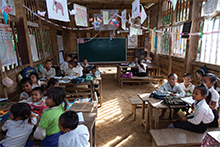Aiming High
Finance & Development, June 2015, Vol. 52, No. 2

New development goals could spur progress toward better-quality life around the world
2015 is a banner year for global development. It marks the deadline for the Millennium Development Goals (MDGs), ambitious targets for global progress set by world leaders at the United Nations at the turn of the 20th century. And while it might come as a surprise to those in Japan, Europe, or North America, the past 15 years may have been the period of greatest progress in humanity’s quality of life. Not least, the available data suggest that we have seen the fastest declines in global child mortality and absolute poverty in recorded history. As a result, we have far surpassed the first MDG—to halve the number of people worldwide living on less than $1.25 a day.
The year 2015 is also the starting date for the Sustainable Development Goals (SDGs) to be agreed at the United Nations this fall. These goals outline a vision of progress to 2030 covering poverty, health, education, security, the environment, governance, gender equality, and much more. And a conference in Addis Ababa in July this year will try to finance that new agenda. Finally, at a meeting of the United Nations Climate Change Conference in Paris in December, countries will pledge to cut greenhouse gas emissions, with the hope of setting us on a path away from catastrophic global warming.
The next 15 years could be as transformative as the past decade and a half. The draft SDGs reflect a global aspiration for even faster progress. That will take unprecedented effort both within and across countries. The Financing for Development Conference taking place in Addis Ababa was organized to figure out what that effort will look like—and certainly has its work cut out for it. The Paris conference is vital to ensuring that human progress is environmentally sustainable. But perhaps the most important condition for success this year is wider recognition by advanced economies that sustainable development is in their own interest: the world’s economies, health, and well-being are sufficiently intertwined that failure in Addis Ababa or Paris would be as much a tragedy for them as for the developing world.
Goals for a new millennium

The MDGs emerged from the Millennium Declaration, a statement by leaders gathered at the United Nations in 2000. The document was filled with aspirations for a just and lasting peace, respect for human rights and fundamental freedoms, and regard for nature. But it also included specific targets drawn from a decade of UN conferences: cutting in half the proportion of people living on less than a dollar a day (later increased to $1.25 in 2005 dollars); universal completion of primary school and gender equality in education enrollment; reduction of maternal mortality by three-quarters and of under-five child mortality by two-thirds; and reversal of the spread of HIV/AIDS, the scourge of malaria, and other major diseases. These targets formed the basis for six millennium goals, joined by a goal on environmental sustainability and one outlining a global partnership for development.
There has been immense and heartening progress in development over the past 15 years, including in the areas highlighted in the MDGs. On a number of measures, the rate of improvement is historically unprecedented. Between 1999 and 2011 alone, the proportion of the population in the developing world living on less than $1.25 a day fell from 34 percent to 17 percent—a halving in just 12 years. China’s spectacular growth performance was a large part of this story (the number of people living under $1.25 fell from 451 million to 84 million in that country), but it was not the only reason.
Over that same period, extreme poverty in the developing countries of sub-Saharan Africa fell from 59 to 47 percent of the population. And over those same 12 years, net primary school enrollment in the sub-Saharan region increased from 58 to 77 percent. That means that one-fifth of the school-age children who would not have been in school at the enrollment levels in 2000 were in school just over a decade later. Girls’ primary school enrollment in 2011 was 74 percent, reflecting convergence in education access between boys and girls over that period.
Perhaps the best news is the dramatic decline in the number of parents who face the pain of burying their child. Between 2000 and 2013, according to the latest World Bank data, the proportion of children born in developing countries who died before their fifth birthday fell from 8.4 to 5.0 percent. In sub-Saharan Africa the decline was from 15.6 to 9.2 percent—more than 40 percent in just 13 years. In Senegal, which has seen a particularly rapid improvement in child health, there was more than a 50:50 chance that a woman who bore the average number of children in 2000 would lose at least one of them before the age of five (56 percent). By 2012 the risk was one in four (26 percent). That is still far too high, but progress has been incredibly rapid.
The lion’s share of credit for these improvements goes to the people and governments of developing countries. It is the hard work of men and women on farms and in businesses that supports their families’ consumption. It is sacrifices by parents that are getting children out of the labor market and into schools and ensuring that children sleep under bed nets and get their shots. And it is the governments of the developing world that are providing the money and public goods necessary to ensure that work and schooling pay off in terms of a better life. Developing countries worked hard to achieve the kind of macroeconomic stability that underpins growth. Between 2000 and 2015, annual government revenues in emerging market and developing economies climbed from about $3.2 trillion to $9.3 trillion according to IMF World Economic Outlook database figures. These revenues are the backbone of the health and education services, roads and electricity lines, and legal systems that allow commerce to flow and lives to improve.
But global cooperation and exchange—flows of goods, services, people, knowledge, and ideas—played a huge part too. Take China’s progress against poverty: Chinese companies backed by foreign investors that exported their products worldwide were a large part of that country’s economic growth. Foreign-invested enterprises accounted for over half of China’s exports and imports and provided for 30 percent of Chinese industrial output according to that country’s Ministry of Commerce. Between 2000 and 2013, exports accounted on average for 30 percent of the country’s GDP, with accession to the World Trade Organization in 2001 helping sustain the vitality of the country’s export sector. Without international trade and investment, the world’s most rapid decline ever in absolute poverty simply wouldn’t have happened.
Or look at the importance of migration flows to development prospects. Migrants have sent back huge amounts of money to their home countries. Remittances account for 9 percent of Bangladesh’s GDP, 10 percent of Guatemala’s, and 23 percent of Lesotho’s, for example. At least as important, migrant flows lubricate the flow of investment, trade, and ideas (see “A Long Commute, in the March 2015 F&D). In 2000, fully one-third of the high-skilled workers in California’s Silicon Valley were foreign born, and Indian expatriates were responsible for founding 13 percent of the region’s start-ups. But they also maintained links with innovators and entrepreneurs back home, and those contacts were key to building what is now a $146 billion information technology (IT) and business processing industry in India, employing 3.5 million people and exporting more than two-thirds of its output.
When it comes to gains in health, official development assistance has played a significant role. About half the households in sub-Saharan Africa now own a bed net, and the proportion of the population sleeping under a net increased from 2 percent in 2000 to 33 percent in 2011. The majority were financed by aid, and the nets have played an important role in the estimated one-third decline in malaria deaths in Africa since 2000. Most of the funding for vaccines in low-income countries was also made possible through aid, and deaths related to vaccine-preventable conditions have plummeted since 2000: worldwide measles deaths fell from 542,000 to 158,000 between 2000 and 2011.
What role did the millennium goals play in the past 15 years of progress and the international cooperation that supported it
The Millennium Declaration and the goals were aspirational and by no means legally binding, but they did help provide a framework for development dialogue, especially around aid. Between 2001 and 2010, aid as a percentage of donor country GDP climbed from 0.21 to 0.32 percent. And more of that aid went to Africa and social sectors—two focuses of the goals. But my investigation with my colleague Sarah Dykstra of the Center for Global Development suggests there is a weak link between overall aid flows and the speed of improvement in health, education, and other MDG indicators. And while improvement was especially rapid over the past 15 years, it is hard to find a speeding up in those rates since 2000 in particular, according to an analysis by Howard Friedman of Columbia University.
Aid may have had a slight impact on marginally more rapid progress across MDG indicators since the turn of the 21st century. That may sound like only a minor accomplishment, but at the global level such change can still amount to millions of lives saved or improved. And that is enough to make the goal-setting exercise worth trying again.
Sustainable progress?

The potential for continued progress over the next 15 years is considerable. There are risks, of course: Lawrence Summers and Lant Pritchett of Harvard University noted in a recent paper that “abnormally rapid growth is rarely persistent,” which suggests that the recent strong performance of countries and regions, including China, India, and sub-Saharan Africa, may not continue. If that is true, progress against income poverty would slow dramatically. Dani Rodrik, of the Institute for Advanced Study, notes that the manufacturing sector, a vital part of growth in east Asian “miracle” countries, is no longer the source of employment and output it once was—weakening a key mechanism of income convergence. That is to say nothing of the challenges posed by climate change to agricultural production and coastland infrastructure and by diseases such as swine flu on global health and commerce.
On the other hand, developing countries have posted very rapid growth over the past decade despite a declining manufacturing share. New sectors—not least mobile telecommunications—have played an important part in that growth. And most developing countries are entering the era of the SDGs in a considerably stronger fiscal position than at the start of the MDGs. Across developing countries as a whole, debt service as a percentage of GDP, for example, dropped from 5.9 percent in 2000 to 3.1 percent in 2013. And average inflation across developing countries in 2013, at 4.3 percent, was both subdued and lower than in 2000, suggesting a considerably improved macroeconomic situation. If growth is exceptionally strong across the developing world, and all countries sustain the optimistic IMF short-term forecasts for all of the next 15 years, growth could lift all but a few percent of the world’s population above an absolute poverty line of $1.25. Or consider health: the recent Lancet Commission on Investing in Health sees the potential for targeted health expenditures to reduce under-five mortality to below 1.6 percent worldwide by 2035 (from a current average of 7.6 percent in low-income countries).
Ambitious goals

Even such optimistic forecasts as these proved insufficient, however, for the UN Open Working Group, which drafted the SDGs. It called for universal and unprecedented progress across a wide range of development areas. The 17 proposed SDGs and their 169 targets cover everything from nature-friendly tourism to violence against children and from waste management and artisanal fishing to gender inequality, employment, and Internet access. By 2030 the draft goals call for us to have ended extreme poverty and malnutrition; achieved full employment; attained universal health coverage; wiped out AIDS, tuberculosis, and malaria; achieved universal secondary education; ensured universal access to water, sanitation, modern energy, and communications—and much more. And they also call for all that progress to be environmentally sustainable.
If the SDGs are designed to focus the development dialogue, it is hard to see what is excluded from that focus—except civil and political rights. And it is not clear how this massively expanded and extremely ambitious goal-setting agenda will drive actual progress toward development.
But if the world is to come even close to meeting the targets set for 2030 there must be an unprecedented domestic effort backed by similarly unprecedented global cooperation across the range of cross-border flows—not only (or even primarily) aid but also trade, finance, migration, and technology. And that makes July’s Financing for Development Conference a vital moment. Developing countries wanted the conference to take place before the SDGs were agreed, precisely to emphasize that such an ambitious set of development goals could be accomplished only in the context of a strong global partnership.
The good news is that the initial draft of the declaration for the conference, produced in March 2015, is wide ranging and ambitious. The declaration calls for a global package of services to be available to all, covering social and physical infrastructure. It highlights the importance of increasing developing countries’ domestic capacity to deliver development—not least by reaching a revenue-to-GDP ratio of 20 percent. And it also calls for reform and policy commitment on improved tax cooperation, greater multilateral financial flows, support for private sector investment, more and better aid, better access to markets for low-income exports, and improved technology sharing.
But the declaration should offer more specifics: a target for more market-rate financial flows from donor governments and multilateral institutions such as the World Bank and the Asian Infrastructure Investment Bank to support infrastructure rollout; a commitment by donors to fund the costs of the universal package of basic social and infrastructure services that cannot reasonably be met by domestic resources; more information on transparency (including published budget details and government contracts and a public register of ultimate ownership of companies); and a stronger commitment to migration and technology as tools for development.
In everyone’s interest

A strong agreement in Addis Ababa and progress toward the SDGs depend on advanced economies’ understanding that the issue is not altruism but naked self-interest. In 2002, when rich countries took part in the Monterey Conference and discussed global cooperation to meet the MDGs, these countries may have asked, “What can we do for them?” This time around the process can only be seen as “What can we do for each other?” Even though developing countries need global ties to make progress, at issue now is not persuading cash-strapped Organisation for Economic Co-operation and Development finance ministers to be a little less skinflint but tackling a set of global problems that can be resolved only with the support of the developing world.
Take trade: if you look at where the industrialized world is exporting, it is to the developing world. Three-fifths of total U.S. exports go to low- and middle-income countries. U.S. automaker General Motors recovered from the effects of the global financial crisis solely because of exports: in 2009 it sold nearly as many cars in China as in the United States. And what about public finance? In 2000, average external debt in developing countries was about 83 percent of GDP, and two-thirds of those countries still had external-debt-to-GDP ratios above 50 percent. By 2011, average external debt had plummeted to 42 percent, and fewer than 1 in 3 had a ratio higher than 50 percent. That improved fiscal situation contributed significantly to the ability of international financial institutions such as the IMF to focus their resources and attention during the crisis on rich countries like Greece, Ireland, and Portugal.
Or look at health: if western African nations, including Nigeria and Senegal, had not stopped the spread of Ebola and the outbreak had reached Lagos, Dakar, and beyond, the global cost would have been immense in terms of disrupted trade and travel—in addition to the tragic loss of life. World Bank estimates suggest a severe flu pandemic could cost the world $3 trillion, mostly because of disrupted commerce—and a more deadly disease would cost even more. The only way to stop new pandemics in a globalized world is to tackle them fast when they emerge, and that means strong local health systems.
Then there is migration: growth in the Indian IT sector relied on skills transfer from the United States, but U.S. growth relies on immigrants, who account for about a quarter of the country’s patent applications. And U.S. health depends on the rest of the world, not only because of the threat of pandemics, but because one-fifth of the nurses working in the United States were educated abroad. As the industrial world ages, its demand for migrants will only grow.
And finally, when it comes to sustainability, the developing world is already the major player: it will soon be responsible for two-thirds of annual carbon dioxide emissions and is home to the great majority of the planet’s biodiversity.
Far too many children still die of easily prevented illnesses, and many who survive are failed by schools that don’t teach, economies that don’t provide good jobs, and utilities whose water and power are unreliable. But our global progress against those ills since the turn of the millennium has been incredible. The world would benefit immeasurably if that progress accelerated over the next 15 years—in a way sustainable over the centuries that follow. This is why we all need a strong global financing deal from Addis Ababa this summer, followed by a forceful deal on climate in Paris. Global cooperation is increasingly important to deliver sustainable development progress. Without it, all the fine words spoken and goals for progress set at the General Assembly in New York will be so much hot air and stale ink. ■
Charles Kenny is a Senior Fellow at the Center for Global Development and author of The Upside of Down: Why the Rise of the Rest Is Great for the West.
References
Friedman, Howard, 2013, “Causal Inference and the Millennium Development Goals (MDGs): Assessing Whether There Was an Acceleration in MDG Development Indicators Following the MDG Declaration,” MPRA Paper No. 48793 (Munich: Munich Personal RePEc Archive).
Kenny, Charles, with Sarah Dykstra, 2013, “The Global Partnership for Development: A Review of MDG 8 and Proposals for the Post-2015 Development Agenda,” CGD Policy Paper 026 (Washington: Center for Global Development).
Summers, Lawrence H., and Lant Pritchett, 2014, “Asiaphoria Meets Regression to the Mean,” NBER Working Paper No. 20573 (Cambridge, Massachusetts: National Bureau of Economic Research, October).


